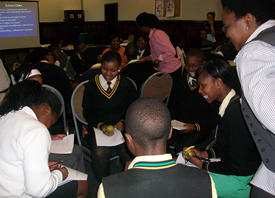| 42% of getS.E.T.go! readers think that the development of a 3D touch screen is a great idea and an exciting development for science. | |
| 17% are indifferent. | |
| 40% think it’s a waste of money and a gimmick. |
It is estimated that South Africa’s new Science & Technology Train, which is currently under development, will reach 14 000 learners each year.
Transnet Rail Engineering at Koedoespoort will complete the train’s renovations.
Join the club!
 |
Eastern Cape learners seen at the science club workshops hosted by SAIAB and the DoE earlier this year. | |
 |
Representatives from the DoE, SAIAB and the Centre for Social Development at Rhodes University also attended. |
By Siphokazi Nonyukela of SAIAB
“Put your hands in your pockets, take out your keys and build your future towards science,” says Sivuyile Manxoyi of the South African Astronomical Observatory (SAAO) in Cape Town. Manxoyi is the champion of a movement to establish active school science clubs countrywide, to entice and nurture budding young scientists.
The South African Institute for Aquatic Biodiversity (SAIAB), in collaboration with the Grahamstown District Office of the Eastern Cape Department of Education (DoE), recently invited SAAO’s Sivuyile Manxoyi and his colleague, Cedric Jacobs, to run a science club workshop for learners from local schools in the Makana region.
Manxoyi and Jacobs addressed some 40 learners in Grade 11 at Graeme College, offering encouragement and tips for starting a science club at their school. They also shared their words of inspiration with grade 10 to 12 learners from five different schools, at two afternoon workshops at the District Offices of the DoE in Grahamstown.
Their goal is simple: to equip learners with the skills needed to start science clubs at their schools, which will provide opportunities for learners to explore science in interactive, fun, informative and challenging ways.
This initiative is the final activity of the SAIAB’s Bright Sparks Development Programme, developed in 2005 to identify learners who show talent and enthusiasm for science. It aims to expose learners to careers in science and technology, encourage them to continue with science subjects at school and tertiary level and develop their skills, knowledge, values and attitudes. In 2010 science kits were donated to the five schools represented at this year’s workshop as part of National Science Week. The workshop was a follow-up to ensure that the learners make maximum use of the kits, and that the whole school derives optimum benefit.
The workshops yielded some interesting feedback, confirming that many learners do not take up science careers because “it’s too difficult … we are not exposed to science”. Manxoyi encouraged them to change their attitude, saying that “when you start believing that you can master science, you will”.
He emphasised that science clubs create a platform for the schools to work together as well as with other institutions such as Rhodes University and SAIAB, where the learners can find resources, information, inspiration and role models.
To show just how easy - and how much fun - a science club can be, workshop participants were taught the basics of starting a club, where to locate it, how to set objectives and draw up a constitution, and how to publicise their club through social networking mediums such as facebook and blogs.
They also solved a few science game challenges, such as how to measure out four litres of water using a full five-litre bottle and an empty three-litre bottle. Other games included cutting a cake only three times to form eight pieces, and combining different coloured balloons to form atoms.
“Our club is interested in working closely with Rhodes University and establishing a partnership with the Dean of Sciences,” said Sanele Ntshingana, president of the science club at Nathaniel Nyaluza High School. “We will have a monthly newsletter communicating all our activities.”
Other feedback came from Hendrik Kanise learners in Alicedale, who said that they would work closely with their teachers to develop “a dynamic club that will create curiosity about science in other learners”.
